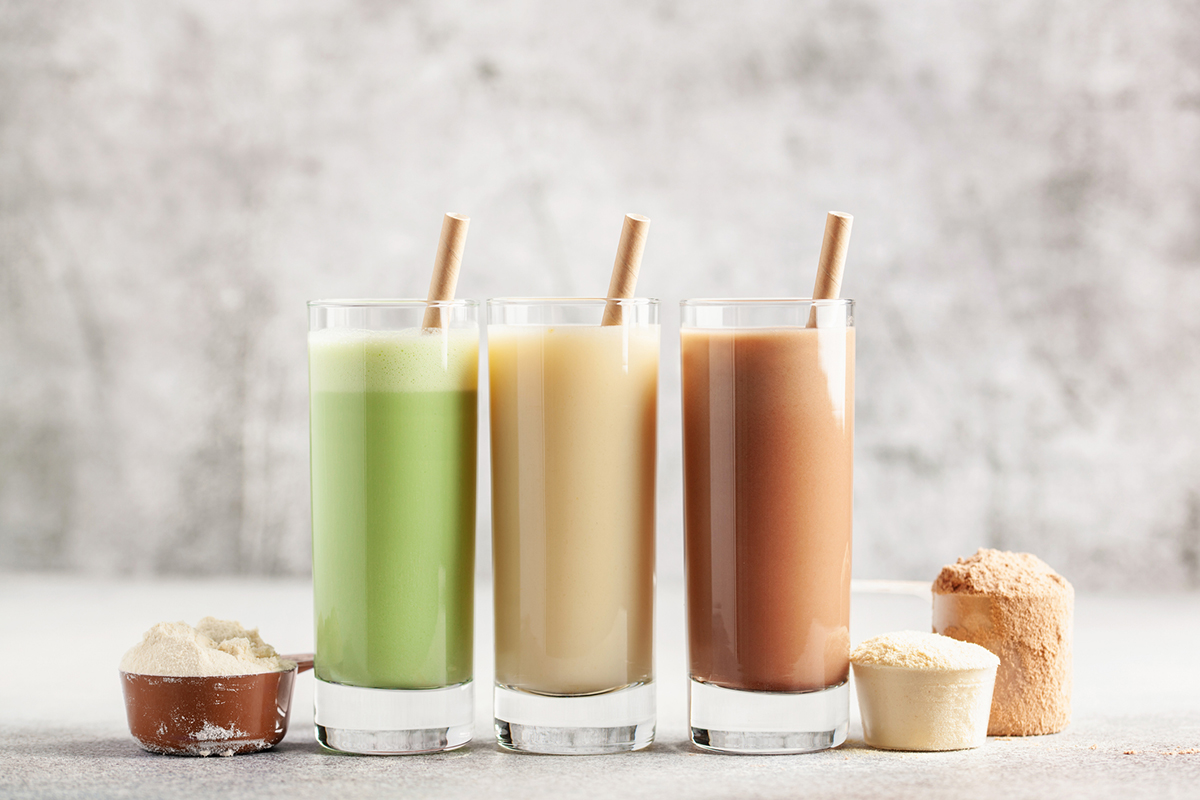Lately, I’ve been sharing with Intelligent Medicine listeners that I’ve been augmenting my diet with a morning protein shake. Some of you have asked me about the specific ingredients and their rationales. The following is my response to your inquiries:
I start by placing a cup and a half of unsweetened vanilla Milkadamia®️and around a half cup of ice cubes into a blender. Milkadamia® is a relatively clean milk alternative (I’m dairy-sensitive) consisting of macadamia nuts and small amounts of pea protein with some natural thickeners and vitamins thrown in. You can substitute rice, oat, cashew or almond milk if you like, but I prefer the fat profile of macadamia that skews toward mono- and saturated fatty acids instead of Omega-6s present in other “milks” (which sometimes contain carrageenan).
Milkadamia®’s website touts:
“Macadamia milk is a plant-based alternative to dairy milk that’s lactose free, soy free, and gluten free. It’s also cholesterol free and carrageenan free. Macadamia milk is a good option for people following Keto and Paleo diets because it’s high in fat and low in sugar compared to almond milk.”
I add half an avocado which, when blended, creates a smooth, creamy texture. Avocados are a rich source of vitamins, soluble fiber, and monounsaturated fats. They provide satiety and help regulate blood sugar.
Then, I add the following ingredients:
Whey protein: 1 scoop = 20 grams. It’s now acknowledged that protein requirements for older adults are greater than previously estimated. Sarcopenia—progressive age-related muscle loss—is a challenge for seniors. To forestall frailty, it’s recommended that over-50s consume more protein and engage in resistance exercise.
Questions arise as to the fungibility of different protein sources. Options abound—including vegan: whey, casein, pea, soy, hemp, rice, egg. Are they equivalent in terms of efficacy for muscle support?
It boils down to absorbability and completeness of their amino acid constituents. Plant-sourced protein powders—unlike dairy or egg-derived alternatives—don’t provide a balanced spectrum of essential amino acids, especially the branched chain ones like leucine.
According to Healthline:
“Whey protein powder is considered a complete protein since it contains all nine essential amino acids — the building blocks of protein. It also contains leucine, isoleucine, and valine, which are branched-chain amino acids (BCAAs) important for muscle building.
The protein content of plant-based protein powder depends on which plant it’s made from. Plant-based powders typically contain fewer BCAAs than whey powders. Plus, only soy protein powder is considered complete.”
But is soy protein really equivalent to whey? Yes, according to this review, but only when a dollop of leucine is added to it.
Other reviews find whey superior to soy. This one concluded:
“Compared to soy, whey protein is higher in leucine, absorbed quicker and results in a more pronounced increase in muscle protein synthesis.”
And another study comparing whey vs. soy protein consumption by obese subjects found more weight loss and reduced waist circumference in the whey consumers:
“Through yet-unknown mechanisms, different sources of dietary protein may differentially facilitate weight loss and affect body composition.”
Staving off sarcopenia is important because skeletal muscle reserve plays critical roles, not just in maintaining physical strength, but also for countering insulin resistance and inflammation.
An added benefit of whey protein is that it’s rich in the amino acid building blocks for glutathione.
Creatine: 1 scoop = 5 grams. To boost the anabolic effects of whey protein, I add creatine. The verdict:
“ . . . numerous studies over the past few decades have shown that creatine supplementation has many favorable effects on skeletal muscle physiology and metabolism, including enhancing muscle mass (growth/hypertrophy) . . . current evidence suggests it may exert its effects through multiple approaches, with converging impacts on protein synthesis and myogenesis.”
Creatine is not just for muscle-heads; there’s evidence that creatine supports brain function: “Oral creatine administration may improve short-term memory and intelligence/reasoning of healthy individuals.”
Collagen: 1 scoop = 10 grams. I’ve been taking glucosamine with chondroitin and MSM for a long time to protect my joints, but lately I’ve added collagen. I like Revive collagen by Brightcore because it combines several types of high-quality collagen along with hyaluronic acid. It has a smooth consistency and blends well with other ingredients without a cloying aftertaste.
NTFactor Lipids Powder: 1 scoop = 2.5 grams. Lipid Replacement Therapy is predicated on the notion that our cell membranes require phospholipids; as we age our membranes deteriorate. This includes the scaffolding of our mitochondria on whose structural integrity energy production is predicated. Studies demonstrate NTFactor improves energy and alleviates fatigue.
Colostrum: 1scoop = 5 grams. Colostrum is derived from the early milk of cows, a rich source of immunoglobulins. It’s beneficial for gut health and immunity, and some studies suggest it may support athletic performance: “ . . . there is some positive evidence for beneficial effects of bovine colostrum on body composition and physical performance (including recovery from demanding exercise)”.
Urolithin A: 1 sachet = 500 mg. Urolithin A is a metabolite of pomegranate. Its bioavailability is dependent on bio-transformation by gut microbes whose presence is subject to inter-individual microbiome variability. A Swiss firm makes purified urolithin A under the brand-name Mitopure®️.
Urolithin A’s claim to fame is its ability to support mitochondrial function, which enhances performance. According to a review, via its impact on a process called mitophagy . . .
“Urolithin A clears free radicals, protects mitochondria from damage, and improves the efficiency of energy production. Furthermore, Urolithin A can promote ATP generation in muscle cells. ATP is the primary energy molecule for muscle cells and is crucial for muscle contraction and exercise performance . . . current evidence suggests that Urolithin A may hold promise for enhancing endurance and anti-fatigue capacity, especially with continuous supplementation.”
In practical terms, a study indicated urolithin A improved endurance in older adults:
“ . . . those who received supplementation with 1000 mg of urolithin A had a significant improvement in muscle endurance (number of muscle contractions until fatigue) for both hand and leg skeletal muscles compared with those who used placebo. Plasma levels of several acylcarnitines, ceramides (biomarkers of mitochondrial health), and C-reactive protein were decreased after urolithin A supplementation . . . These findings indicate that urolithin A was safe and well tolerated as well as beneficial for muscle endurance and mitochondrial health in older adults; it may also be a promising approach to counteracting age-associated muscle decline.”
Magnesium: Orthomolecular Reacted Magnesium Powder 1/2 scoop = 3 grams. Active adults can always use additional magnesium, and this magnesium powder is nicely sweetened with Stevia which imparts some sugar-free sweetness to the shake.
Flax oil: 1 Tbsp = 15 grams. Adding some fat imparts more smoothness to the shake and improves its satiety value without enlisting carbs. Flax oil is a source of the omega-3 essential fatty acid alpha linolenic acid, which research suggests may reduce cardiovascular risk:
“The Djousse group found a significant inverse relationship between the intake (in grams per day) of LNA at baseline and subsequent coronary artery calcification. In their most extensive multivariate model, Djousse et al found a relatively graded 65% reduction in odds ratios for calcified plaque from the lowest quintile of intake to the highest (P for trend <0.0001). These data support the hypothesis that LNA has antiatherosclerotic properties.”
Flax oil is also a rich source of lignans which are claimed to confer anti-cancer benefits for the breast, prostate and GI tract.
And now for flavorings. We have options:
Matcha: 1 tsp = 5 grams. This powder imparts the flavor of green tea ice cream, while boosting health. Green tea is a source of L-theanine, which has mood and cognitive effects, as well as EGCG, a premier antioxidant. It delivers a host of benefits for liver, brain, and circulatory system, as well as cancer protection.
Cocoa: 1 scoop = 13 grams. I use the FlavaNaturals®️ FlavaMix®️Cocoa Powder that is standardized to deliver 900 mg of cocoa flavanol per scoop, the amount found in studies to boost cognitive performance. There are also blood pressure and insulin resistance benefits of cocoa.
Studies are mixed on its impact on athletic performance, but one trial states:
“Our findings suggest that a short period of cocoa consumption could be useful in maintaining a good physical fitness, due to the favorable effects on muscle and redox status in athletes during exhaustive exercise.”
Chocolate milk is often recommended as an ideal recovery drink for endurance athletes.
Frozen berries: 1/2 cup. Unsweetened frozen berries are also ideal in the shake. Blueberries, raspberries, strawberries, or blackberries add flavor and beneficial polyphenols.
Yes, we have no bananas! Admittedly yummy in shakes, bananas add superfluous carbohydrate calories without extraordinary micronutrient dividends. Besides, there’s the newly recognized phenomenon of polyphenol steal: Bananas pack high levels of the enzyme polyphenol reductase which impairs the bioavailability of polyphenols (like those from berries, cocoa, green tea, and urolithin A) by up to 87%.
Timing: Then there’s the contentious issue of timing of that post-exercise recovery drink. Is there a crucial “anabolic window” wherein hungry muscles imbibe amino acids for repair, recovery, and optimal hypertrophy? Some contend it’s that golden interval 30-60 minutes after resistance training:
“Dietary protein should be ingested during and/or immediately after cessation of exercise to allow muscle protein synthesis rates to reach maximal levels.”
Others argue that it doesn’t matter so much, as long as it’s within a few hours:
“These findings refute the contention of a narrow post-exercise anabolic window to maximize the muscular response and instead lends support to the theory that the interval for protein intake may be as wide as several hours or perhaps more after a training bout depending on when the pre-workout meal was consumed.”
Because I mostly exercise fasted in the morning, I usually have my shake within an hour after my workout—simply because I’m hungry. But eating a regular high protein post-exercise meal is likely to impart equivalent benefits.
Using this approach over the past 18 months has resulted in a 10-pound weight gain with a reduction in my fat to lean ratio. That’s likely a consequence of more muscle. I also haven’t had to change my pant size (32”) but I’ve had to trade in some of my sport jackets and shirts which were tailored extra slim, presumably because of changes in my upper body.







